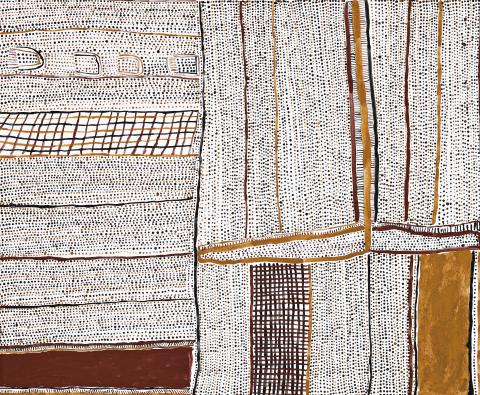UNTITLED, 1997
KUTUWULUMI PURAWARRUMPATU (KITTY KANTILLA)
natural earth pigments and synthetic binder on canvas
79.0 x 96.5 cm
bears inscription verso: artist’s name, skin group: Fire / dance: Rain and Jilamara Arts and Crafts cat.1799
Jilamara Arts and Crafts, Melville Island (stamped verso)
Framed Gallery, Darwin
The Collection of Colin and Elizabeth Laverty, Sydney, acquired from the above in October 2005
A Century of Collecting 1901 – 2001, Ivan Dougherty Gallery, College of Fine Arts, University of New South Wales, Sydney, 29 March – 28 April 2001
Dreaming Their Way: Australian Aboriginal Women Painters, National Museum of Women in the Arts, Washington DC, USA, 30 June – 24 September 2006; Hood Museum of Art, Dartmouth College, Hanover, USA, 7 October – 10 December 2006, cat. 63
Konav, B., Boles, M.S., and Kennedy, B., Dreaming Their Way: Australian Aboriginal Women Painters, National Museum of Women in the Arts, Washington and Scala Publishers, London, 2006, pp. 8 (illus.), 113
Beyond Sacred: Recent Painting from Australia’s Remote Aboriginal Communities: The Collection of Colin and Elizabeth Laverty, Hardie Grant Books, Melbourne, 2008, p. 259 (illus.)
Beyond Sacred: Recent Painting from Australia’s Remote Aboriginal Communities: The Collection of Colin and Elizabeth Laverty, edition II, Kleimeyer Industries Pty Ltd, Melbourne, 2011, p. 289 (illus.)
A magical and delicate ‘white painting’ or ‘pumpuni jilamara’ (meaning ‘good design’), a phrase commonly used by the Queen of Jilamara, Kitty Kantilla, to describe her work, this painting was made in the same year the artist unveiled a series of white-ground paintings on paper and canvas in her third solo exhibition at the Aboriginal and Pacific Art Gallery in Sydney. These paintings have been described by Judith Ryan as ‘studies in radiance.’1 Three of the paintings are illustrated in the catalogue to the artist’s posthumous retrospective exhibition in 2007 at the National Gallery of Victoria.2 In contrast to the busy compositions on black grounds of many of her previous paintings, and on her earlier painted figure sculptures, these works display a solidity of form and simple assuredness of composition mainly struck along horizontal and vertical lines. The same applies to Untitled, 1997, where blocks of dotting made without the use of the pwoja or wooden comb traditionally used by Tiwi artists to make lines of dots, jostle comfortably with accents of ochre and passages of hatched lines that are rarely seen in Kantilla’s work. The only faintly figurative elements in the painting are four arched forms in the top left that are suggestive of the feathered armbands worn by participants in Tiwi ceremonies.
Typical of Kantilla’s paintings, Untitled harks back to what has been termed ‘old style’ Tiwi painting such as that found on early Pukumani burial poles and tutini bark baskets collected on the National Geographic Expedition to the Tiwi Islands lead by the anthropologist Charles Mountford in 1954. Kitty Kantilla lead a traditional life, and although she had a brief experience at the Catholic Mission on Bathurst Island, she moved to the community at Paru on Melville Island in the 1970s, along with a group of elder women, to put some distance between themselves and European influences. At Paru, Kantilla began to make figurative sculptures in ironwood, decorated in body painting designs. As she abandoned sculpture, these designs were the source of inspiration for the paintings of the last seven years of her life.
1. Ryan, J., Kitty Kantilla, National Gallery of Victoria, Melbourne, 2007, p. 80
2. ibid., pl. 31, p.30, pl. 58, p. 51, and pl. 59, p. 52 (illus.)
WALLY CARUANA
